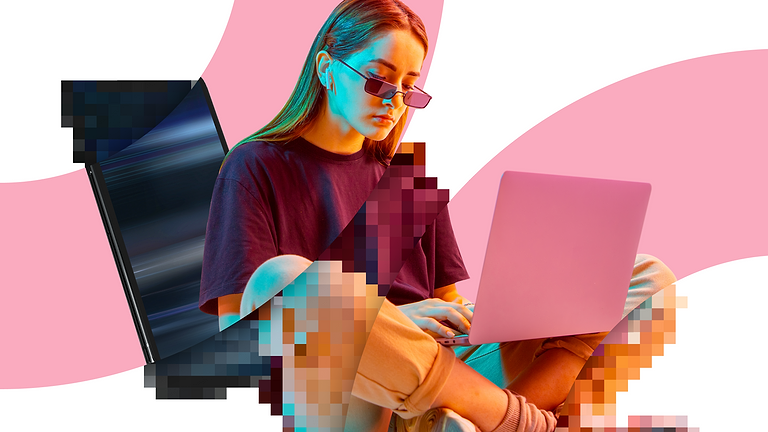WHY IMAGE AND VIDEO COMPRESSION WITH PRESETS IS HURTING YOUR BRAND
And how Media AI-Optimization will take your online business to the next level
PRESETS COMPROMISE VISUAL QUALITY
What was once impossible, compressing videos and images with presets has become a critical component of website optimization. Until last year, all image and video compression tools used presets. That includes highly-sophisticated media optimization platforms and CDN solutions like Akamai and Cloudinary. Presets are an indicator that all your images and videos will be compressed the same, ignoring what is actually visible to someone’s eyes when they look at a website. That all media will be compressed without any understanding of the content within the image or video.
Most compression tools use a single preset, others use up to five to recognize certain cues such as faces and backgrounds. Until recently, these tools with presets were highly buggy and could not sufficiently compress images, and especially videos, without losing a substantial amount of quality. Poor image quality, like slow-loading websites will damage the credibility of your brand or online reputation.
THE IMPORTANCE AND PITFALLS OF VISUAL QUALITY
Since 93% of online shoppers rate visual appearance as a deciding factor when making a purchase online, blurry or pixelated product images are a huge competitive disadvantage to any eCommerce store. As loading speed almost always takes precedence over visual quality by IT professionals, media compression has become the necessary evil of every online business. While some brands, such as ultra-high end fashion companies and design companies will emphasize visual quality over loading speed, this is a minority of websites. And if these websites are at all concerned with conversions (not solely brand awareness) they will inevitably change their strategy to prefer better performance. Even in these cases, slow-loading will greatly affect their brand credibility, so marketing and design teams geared towards visual composition will actually hurt their brand in the long run.
So nearly every website on the internet with any interest in performance, or using a CMS that has an interest in their websites’ performance, uses lossy compression. That means that the quality of the media is highly compromised so websites load faster. The images and videos will always be slightly blurred, sometimes with noticeable compression artifacts, like big square pixels and blotched colors.
VISUAL QUALITY ONLINE IS BEHIND THE CURVE
This seems to be an irresolvable problem. Scouring the internet, it’s easy to observe that the quality of product images and videos is well behind the curve, much lower than you would expect, given the resolutions of the screens we consume our media from. You may also notice that when you have a poor connection on your mobile device, websites will take a long time to load.
The reason for this is solely due to image and video compression with presets. In an attempt to tackle the slow-loading mobile problem most eCommerce websites will use some form of compression tools or CDN solutions to reduce the file size of their media, just to try to make their website load faster. However, what many eCommerce stores don’t realize is that the technology behind many of these compression tools is about 30 years old.
MOST WEBSITES STILL USE 30 YEAR OLD FORMATS
Would you use a 30 year old computer? Of course not, but you probably do use 30 year old image formats.
Approximately 80% of websites are displaying JPEGs and PNGs, both developed in the early 90s to resolve this very problem. These JPEGs and PNGs are heavily compressed, as their origin files are very large. Since the technology is well behind the resolution of new monitors and especially, high-res devices like iPhones, the visual quality on even the largest multibillion dollar eCommerce stores do not display their product images particularly well.
In simple terms, the technology behind those tools will guess the quality requirement and use a “one size fits all” preset approach to compress billions of different media files, and by doing so will reduce and damage the quality of the products you sell online. The problem with this approach is that these existing old generation compression tools do not know what pixels in the image are important to the human eye visually. This means they compress pixels in a way that causes the image to lose visual quality and appear blurred or not as sharp as the original. Unfortunately, by using these compression tools, you lose the information in the image which people actually care about.
STOP DOING IT ALREADY: THERE IS NO LONGER ANY REASON TO USE JPEG

Beyond the preset problem, most websites do not even opt for modern formats like WEBP (developed in 2010) or AVIF (2019) that can provide substantial quality improvement, often ~50% from high-quality, original PNG files, without losing any perceptible visual quality. Instead they overcompress JPEG and PNG files, when they could just as easily cut the file size of their media by half without compromising the quality.
This was once understandable, because it took some time for the format to become adopted. But now that WEBP is supported by 97% percent of internet users’ browsers, and AVIF, a much more versatile image format supported by 79% of all browsers, should largely be a thing of the past. Even AV1, the sister video format of AVIF, is supported by 73% of users and is heavily trafficked around the world by streaming services like Netflix.
Even though there is virtually no reason not to, WebP is only used by 6.3% of websites. And while AVIF has been adopted by all Chromium-based browsers, which are swallowing the market share of internet users internationally, it is still only used by a negligible percentage of websites. Beyond formatting in order to make the newer formats fast-loading enough for Google Core Web Vitals metrics and actual consumer expectations, this media needs to be compressed and lose some quality. While compressed AVIFs are much clearer than JPEGs, in order to make your visuals look life-like, compression is not the answer.
STOP COMPRESSING, START CONVERTING
Make JPEGs up to ~99% smaller. The almost unfair advantage now available is called Neuroscience Media Optimization. It was developed by SpeedSize™. By understanding human visual limitations, SpeedSize™ can recreate media without losing quality to a level that was once impossible. It will also auto-deliver the correct format for each unique visitor. So if for instance someone is searching from a browser that doesn’t support AVIF, a WEBP or JPEG will be delivered to them, in the smallest possible file size for their screen that does not lose visual quality.
SpeedSize™ is able to do this by understanding the limits of human visual perception. When you look at images, the human brain only sees around 1 to 10 percent of the visible information on the screen. Using our proprietary technology, we AI-analyze those images by identifying up to 100 points of interest (faces, skin, textures, background, foreground, etc.), enhancing them and removing the bits of data in the image file that our eyes simply cannot recognize.
This makes images and videos up to 99% smaller with no visible loss in quality, helping websites load up to 10x faster.
Since Google Core Web Vitals scores are improved by loading speed and visual quality, SpeedSize™️ optimized websites get favorable SEO rankings, leading to more organic traffic. They also improve customer experience and thus are able to convert more sales from a larger, better engaged audience.
If you want to optimize your website’s images and videos, to drive more engagement and conversion, check out SpeedSize™️, the new standard in media optimization.






